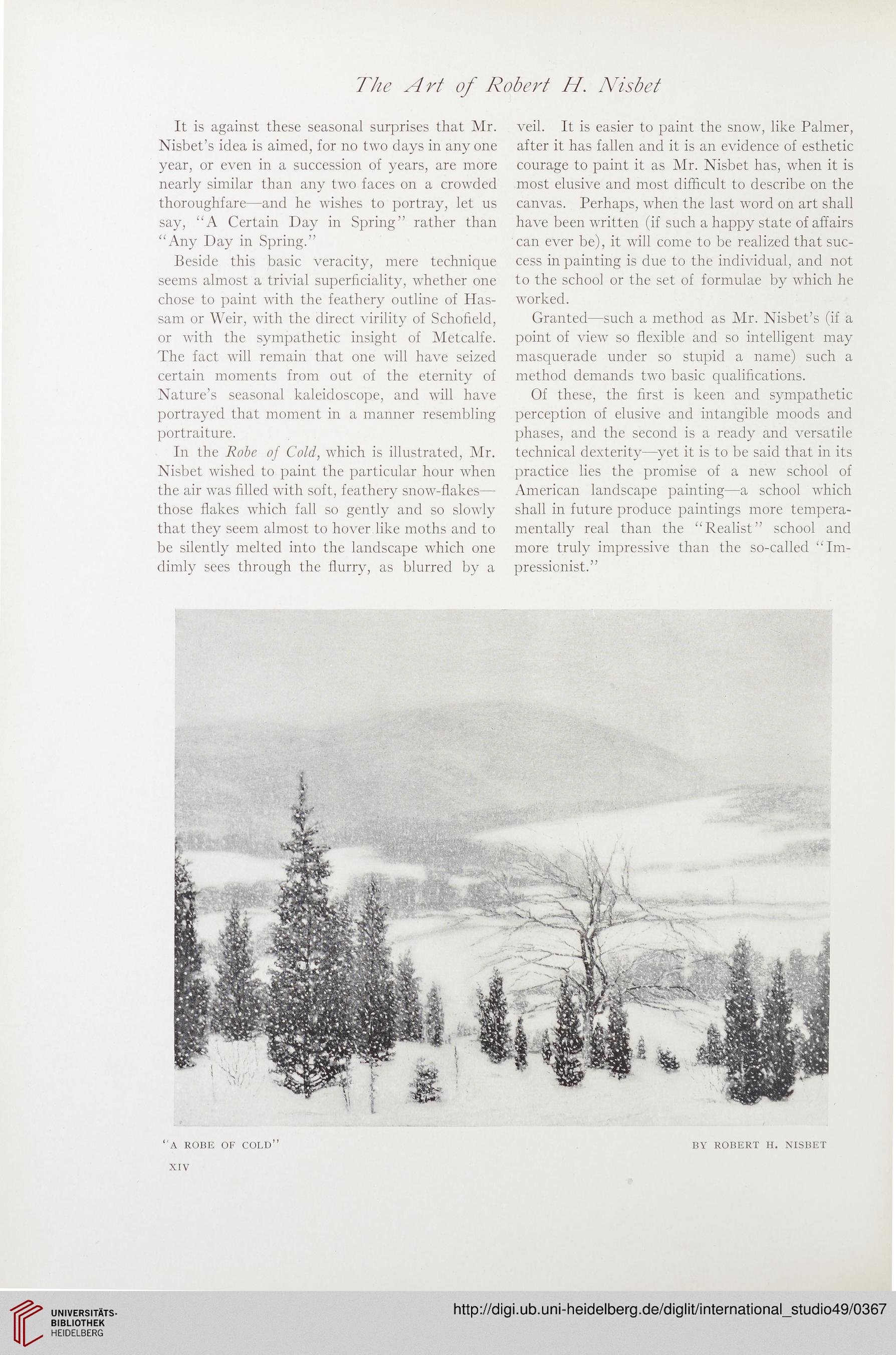The Art of Robert H. Nisbet
It is against these seasonal surprises that Mr.
Nisbet’s idea is aimed, for no two days in any one
year, or even in a succession of years, are more
nearly similar than any two faces on a crowded
thoroughfare—and he wishes to portray, let us
say, “A Certain Day in Spring” rather than
“Any Day in Spring.”
Beside this basic veracity, mere technique
seems almost a trivial superficiality, whether one
chose to paint with the feathery outline of Has-
sam or Weir, with the direct virility of Schofield,
or with the sympathetic insight of Metcalfe.
The fact will remain that one will have seized
certain moments from out of the eternity of
Nature’s seasonal kaleidoscope, and will have
portrayed that moment in a manner resembling
portraiture.
In the Robe of Cold, which is illustrated, Mr.
Nisbet wished to paint the particular hour when
the air was filled with soft, feathery snow-flakes—
those flakes which fall so gently and so slowly
that they seem almost to hover like moths and to
be silently melted into the landscape which one
dimly sees through the flurry, as blurred by a
veil. It is easier to paint the snow, like Palmer,
after it has fallen and it is an evidence of esthetic
courage to paint it as Mr. Nisbet has, when it is
most elusive and most difficult to describe on the
canvas. Perhaps, when the last word on art shall
have been written (if such a happy state of affairs
can ever be), it will come to be realized that suc-
cess in painting is due to the individual, and not
to the school or the set of formulae by which he
worked.
Granted—such a method as Mr. Nisbet’s (if a
point of view so flexible and so intelligent may
masquerade under so stupid a name) such a
method demands two basic qualifications.
Of these, the first is keen and sympathetic
perception of elusive and intangible moods and
phases, and the second is a ready and versatile
technical dexterity—yet it is to be said that in its
practice lies the promise of a new school of
American landscape painting—a school which
shall in future produce paintings more tempera-
mentally real than the “Realist” school and
more truly impressive than the so-called “Im-
pressionist.”
"A ROBE OF COLD” BY ROBERT H. NISBET
XIV
It is against these seasonal surprises that Mr.
Nisbet’s idea is aimed, for no two days in any one
year, or even in a succession of years, are more
nearly similar than any two faces on a crowded
thoroughfare—and he wishes to portray, let us
say, “A Certain Day in Spring” rather than
“Any Day in Spring.”
Beside this basic veracity, mere technique
seems almost a trivial superficiality, whether one
chose to paint with the feathery outline of Has-
sam or Weir, with the direct virility of Schofield,
or with the sympathetic insight of Metcalfe.
The fact will remain that one will have seized
certain moments from out of the eternity of
Nature’s seasonal kaleidoscope, and will have
portrayed that moment in a manner resembling
portraiture.
In the Robe of Cold, which is illustrated, Mr.
Nisbet wished to paint the particular hour when
the air was filled with soft, feathery snow-flakes—
those flakes which fall so gently and so slowly
that they seem almost to hover like moths and to
be silently melted into the landscape which one
dimly sees through the flurry, as blurred by a
veil. It is easier to paint the snow, like Palmer,
after it has fallen and it is an evidence of esthetic
courage to paint it as Mr. Nisbet has, when it is
most elusive and most difficult to describe on the
canvas. Perhaps, when the last word on art shall
have been written (if such a happy state of affairs
can ever be), it will come to be realized that suc-
cess in painting is due to the individual, and not
to the school or the set of formulae by which he
worked.
Granted—such a method as Mr. Nisbet’s (if a
point of view so flexible and so intelligent may
masquerade under so stupid a name) such a
method demands two basic qualifications.
Of these, the first is keen and sympathetic
perception of elusive and intangible moods and
phases, and the second is a ready and versatile
technical dexterity—yet it is to be said that in its
practice lies the promise of a new school of
American landscape painting—a school which
shall in future produce paintings more tempera-
mentally real than the “Realist” school and
more truly impressive than the so-called “Im-
pressionist.”
"A ROBE OF COLD” BY ROBERT H. NISBET
XIV




